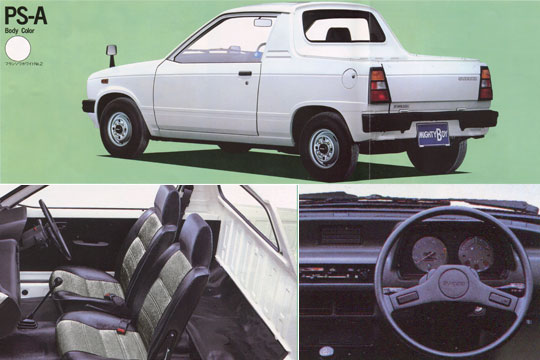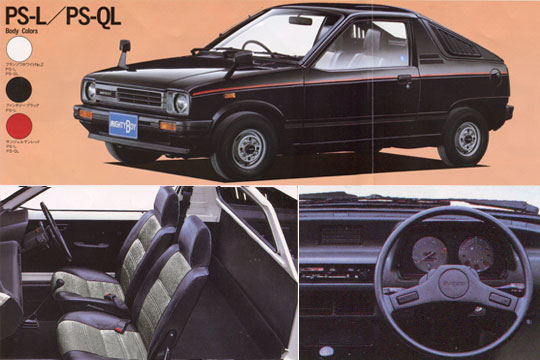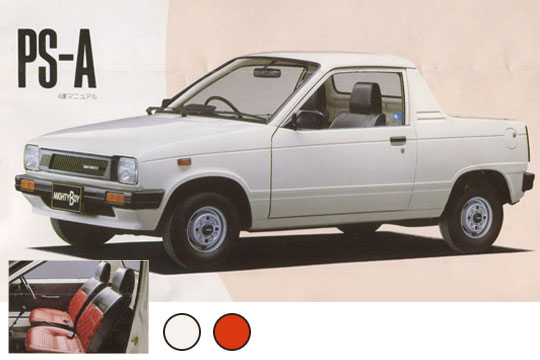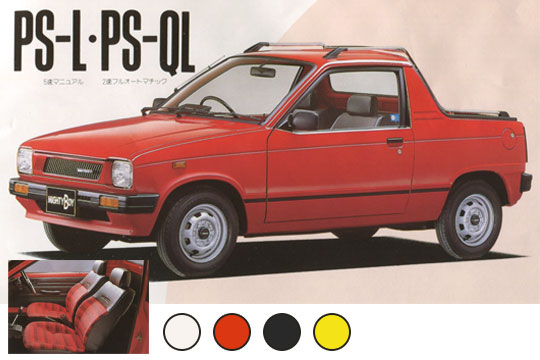
History of the Suzuki MightyBoy
A summary of MightyBoy production and sales in Japan and Australia.
Read time: ~5 minutes.
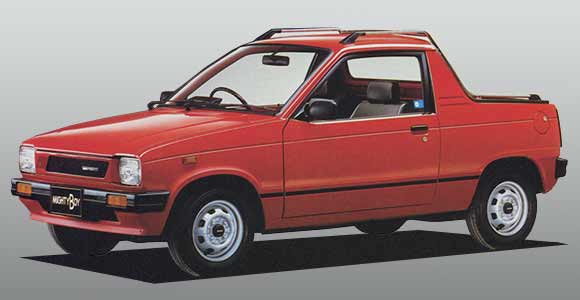
The Suzuki MightyBoy is a two-seater coupe–utility vehicle, developed and manufactured by Suzuki Japan between 1983 and 1988.
Designed to fit within Japanese keijidōsha regulations (which limit engine capacity and external body dimensions), the MightyBoy was the only ‘bonnet type’ utility vehicle produced in the 550 cc era of kei class from 1976-1990. Outside of Japan, the MightyBoy was officially exported to Australia and Cyprus.
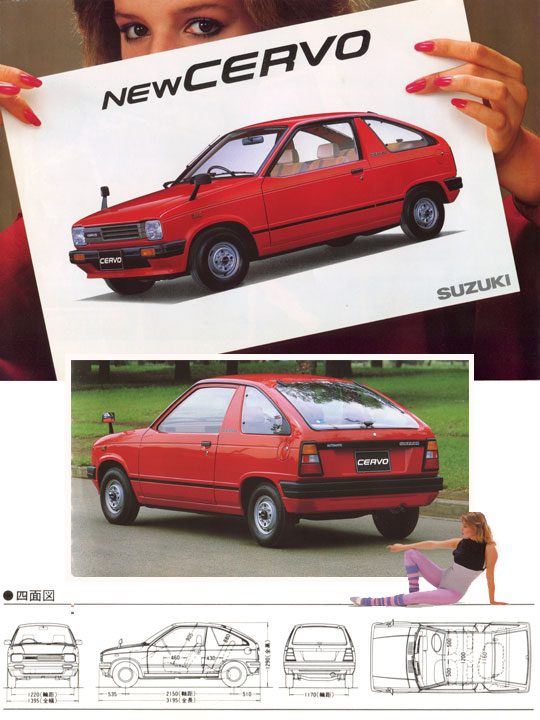
Origin
While the MightyBoy's roots can arguably be traced back to the Suzulight Carry FB commercial utility vehicle of the 1960s, the real genesis came with the introduction of the second generation Suzuki Cervo (SS40C) in 1982.
Based on a platform that was shared with Fronte (SS40S) and Alto (SS40V) models, the second generation Suzuki Cervo was a streamlined 2 door 'fast back' sports coupe featuring a frameless glass rear hatch. The most significant change from the previous generation of Cervo was the switch to front engine, front wheel drive layout. (Previous Cervo models were rear engine, rear wheel drive configuration). The ‘new’ Cervo also benefited from changes to keijidōsha regulations which permitted a larger cabin area, and a larger, more powerful engine.
With the aim of producing an extremely cheap and practical vehicle, Suzuki took the Cervo and revised the design of the rear section by removing the roof, windows and back seat to create a cargo area. The addition of a tailgate completed the conversion from coupe to utility.
Production timeline
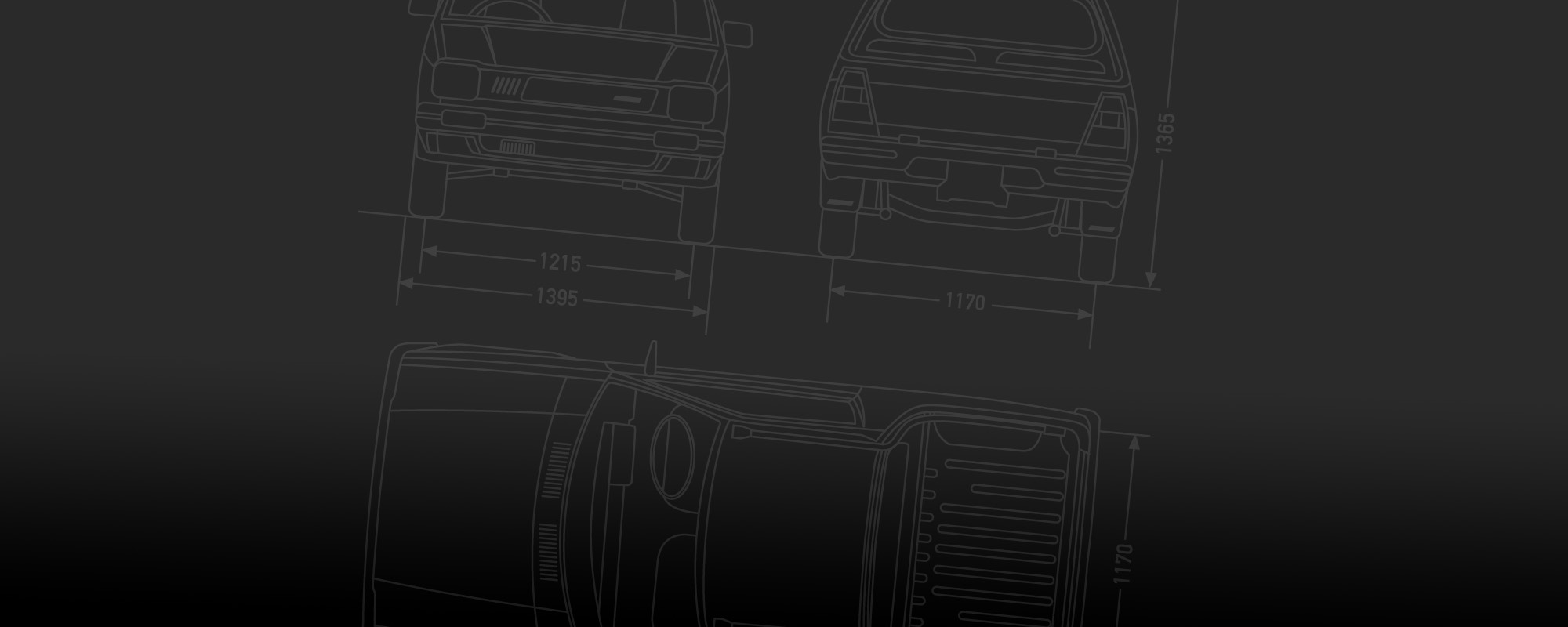
1982 – Launch of 2nd gen Cervo
The second generation Suzuki Cervo was launched in 1982, providing a base platform for the MightyBoy.
1983 – Suzuki MightyBoy launched
MightyBoys went on sale in Japan during 1983, becoming the cheapest new vehicle available in the keijidosha (kei car) segment.
1985 – MightyBoy exports commence
A mid-production run styling update was released in early 1985. This coincided with the start of of short-lived exports to Australia and Cyprus.
1988 – Production ceases
During development of the next generation Alto, Suzuki discontinued MightyBoy production. Existing stock was sold through 1988.
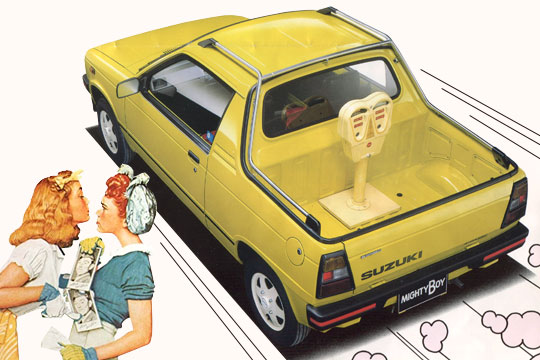
Production & sales (Japan)
Following development and manufacturing, the Suzuki MightyBoy went on sale in Japan in February 1983. At launch it was priced at ¥450,000 – making it the cheapest vehicle (with four wheels) available in Japan at the time. The MightyBoy was was pitched at the youth and small businesses markets, particularly those who needed to transport equipment and small goods.
Sales were underwhelming throughout the MightyBoy's new sales lifetime, particularly when compared to the Suzuki Fronte & Alto hatchback models, which were sold at similar price to the MightyBoy but offered greater versatility and cargo security. Sales were also affected by unfavourable comparisons to ‘cab-over’ utility vehicles like the Daihatsu HiJet and Suzuki Carry, which both had more load carrying capacity at a similar price point. Slow sales and the looming replacement of the SS40 chassis platform led Suzuki to discontinue MightyBoy production in 1987. Inventory stock was sold through 1988 before it was resigned to history.
During the MightyBoy's production run in Japan there were two model series, and a total of 5 model variants (excluding exported versions).
Series 1
The first series of MightyBoy was sold in Japan between February 1983 and January 1985.
The Series 1 MightyBoy made use of the Cervo’s mechanical underpinnings, including the 543 cubic centimetre 3 cylinder engine (F5A) in front wheel drive configuration. Output was rated at 19.8 kilowatts (6,000 RPM) and 43 n/m of torque (3,500 RPM). Fuel consumption was stated as 3.7 litres per 100 kilometres, however this is a very optimistic figure. The MightyBoy's suspension package included independent macpherson coil over strut units at the front, and leaf springs with a trailing axle at the rear. Braking duties were performed by drums both front and rear, housed behind 10 inch steel wheels.
Three trim levels were available in the first series of MightyBoy. These were designated PS-A and PS-L / PS-QL. While PS-A and PS-L were mechanically identical, the PS-QL featured a 2 speed automatic transmission instead of the 4 speed manual.
More info: Japanese sales brochure for the Series 1 MightyBoy
Suzuki MightyBoy — Series 1
Model code: SS40T
Trim levels: PS-A, PS-L, PS-QL
Purchase price: From ¥450,000
Dimensions
Height: 1358 mm
Length: 3195 mm
Width: 1395 mm
Kerb weight: 510–540 kg
Load capacity: 200 kg
Drivetrain
Engine: 3 cylinder, 6 valve, water cooled, 4 stroke
Power: 19.8 kw @ 6,000 RPM
Torque: 43 nm @ 3,500 RPM
Transmission: 4 speed M/T, 2 speed A/T
-
Series 1 — PS-A
This was the base trim level, equipped with only the bare essentials, and missing some of the interior trim coverings of the higher spec models. Available in a single colour - French White No. 2.
-
Series 1 — PS-L/PS-QL
This trim level offered the choice of an additional two colours - Fantasy Black and Saint Germain Red. It also included standard equipment not featured on the PS-A such as a radio, cigarette lighter, parcel tray behind the seats, and a cover for the cargo area.
Series 2
Sales of the second series MightyBoy started in February 1985 and ceased in 1988, coinciding with an export period to Australia and Cyprus.
The second series MightyBoy was released in February 1985, corresponding with minor updates to the Alto/Cervo/Fronte model range. External changes were mostly cosmetic, and included an updated grill design, and the addition of chrome rails on the roofline that added to the functionality of the cargo area by allowing goods to be tied down. The previous round headlights were replaced by rectangular units, which introduced a high/low beam function.
Inside, the dashboard (previously shared with the Suzuki Fronte) was swapped to match the Cervo. Seat fabrics were updated, and a tacho was made available for PS-L / PS-QL trim levels.
Mechanically, the MightyBoy retained the 543 cc engine from the first series, but an upgraded carburettor bumped power from 19.5 to to 22.7 kilowatts. For the first time a 5 speed manual transmission was available — this had the same gear ratios as the 4 speed, with an overdriven fifth gear.
The series 2 range carried over the three trim levels from the first series: PS-A, PS-L and PS-QL, with some minor updates and changes.
More info: Japanese sales brochure for the Series 2 MightyBoy
Suzuki MightyBoy — Series 2
Model code: SS40T
Trim levels: PS-A, PS-L, PS-QL
Purchase price: From ¥450,000
Dimensions
Height: 1365 mm
Length: 3195 mm
Width: 1395 mm
Kerb weight: 510–540 kg
Load capacity: 200 kg
Drivetrain
Engine: 3 cylinder, 6 valve, water cooled, 4 stroke
Power: 22.7 kw @ 6,000 RPM
Torque: 44 nm @ 3,500 RPM
Transmission: 4 or 5 speed M/T, 2 speed A/T
-
Series 2 — PS-A
PS-A continued as the base model, and aside from a few cosmetic changes was almost identical to the series 1 specification.
-
Series 2 — PS-L / PS-QL
These variants were fitted with a 5 speed (PS-L) or two speed automatic (PS-QL) transmission, and disc brakes on the front hubs. The rear tub cover from the series 1 was discontinued, replaced with chrome tie down rails. Inside the cabin, a redesigned dashboard was equipped with a new instrument cluster featuring a tachometer. Other upgrades included 3 speed wipers, and retractable lap/sash seat belts. Air conditioning was available as an option, along with a choice of several optional wheel designs.
-
Medium Rare is an elite author known for offering high-quality, high-value products backed by timely and personable support. Recognised and awarded by Envato on multiple occasions for producing consistently outstanding products, it's no wonder over 20,000 customers enjoy using Medium Rare templates.
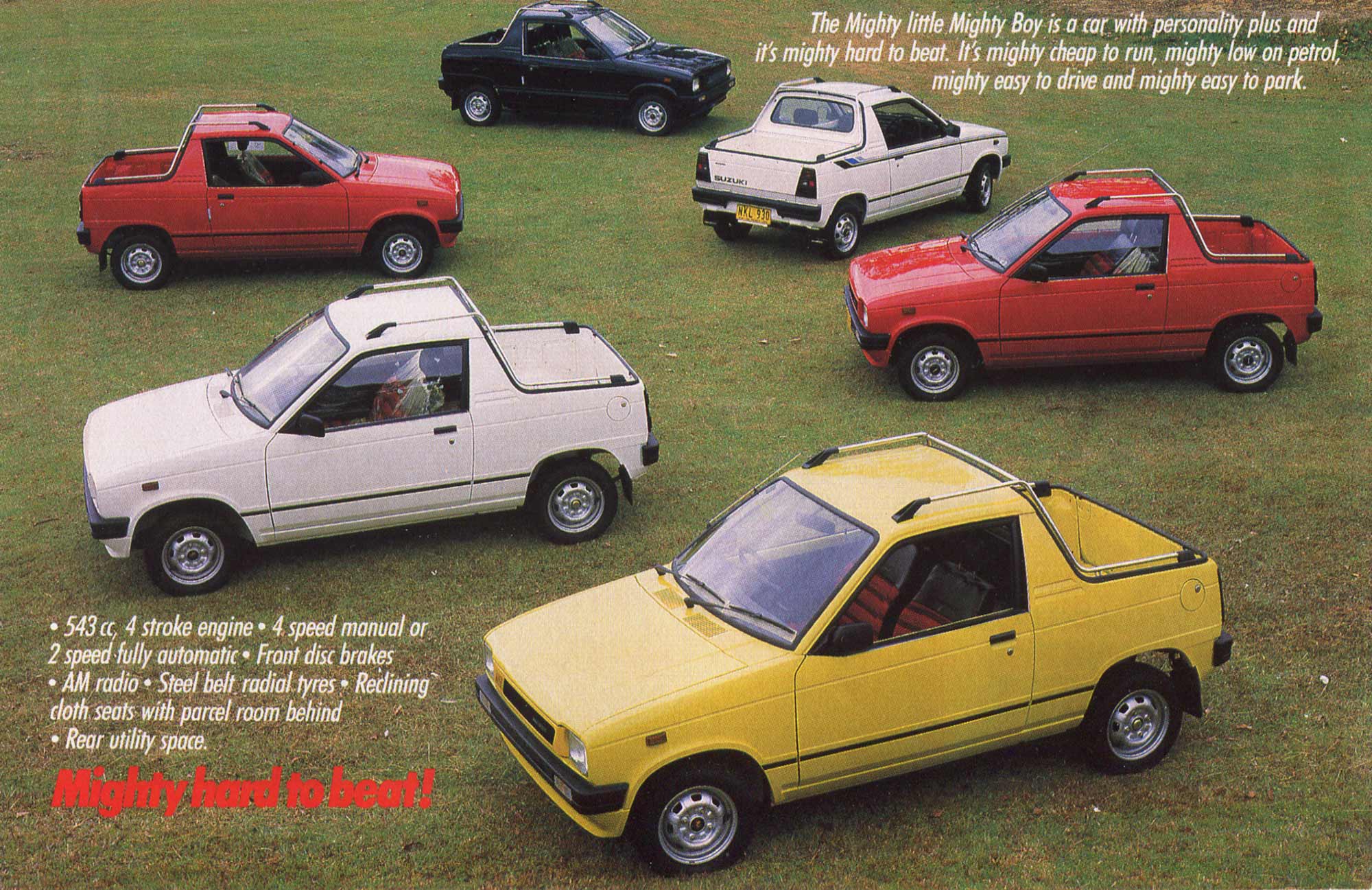
Australian exports
MightyBoys were exported to Australia between 1985 and 1988 through deals with separate importers in each state.
As a commercial vehicle the MightyBoy was subject to significant tax incentives which made them appealing to Australian importers. They were sold alongside the Carry Van, Carry Truck and a commercial van version of the Suzuki Hatch.
Only a single model of the MightyBoy was offered in Australia, with the choice of a 4 speed manual or 2 speed automatic transmission. Dealer options were limited to 12” alloy wheels, aftermarket air conditioning, tonneau covers and cargo canopies. Because these options were sourced and fitted by individual Suzuki dealers, there were a variety of differences between product types and fitments.
The commercial tax discounts resulted in a retail price of $5,795 in 1985 (manual transmission). At the time, this was the cheapest new vehicle available in Australia. Unfortunately, local importers no longer have import records, however estimates range between 3000 and 5000 vehicles brought into the country.
More info: Australian MightyBoy sales brochure
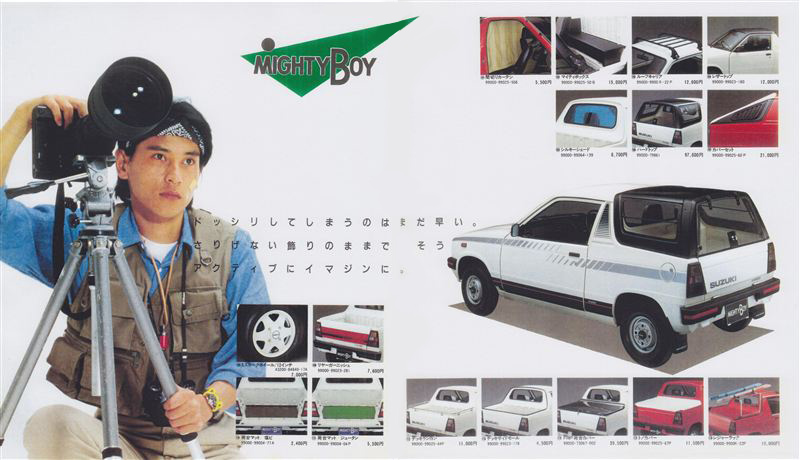
Accessories
In Japan, dozens of factory accessories were available for the MightyBoy throughout its production run, and Suzuki created catalogues to showcase the range of parts. In addition, several third party suppliers produced aftermarket accessories ranging from luggage racks and fibreglass canopies to alloy wheels and body kits.
In Australia, the variety of accessories was limited. There were two locally produced fibreglass canopies available; a high-top style made by CarryBoy, and a flat-top style (manufacturer unknown).
Curiously, MightyBoys exported to Australia were not equipped with a tonneau cover for the cargo area. Individual Suzuki dealers were responsible for sourcing their own tonneau covers locally, resulting in variations in materials and fixing methods. Some stretch over the chrome tie-down rails, while others slip underneath. Some have press stud fixings, and others have bungee-cord straps.
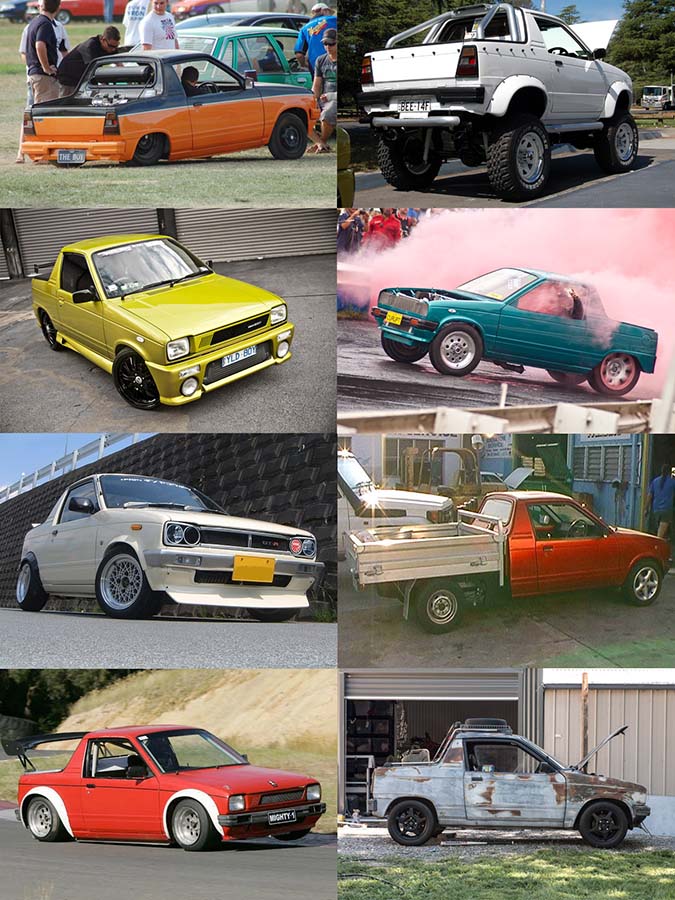
Legacy
Over time, vehicles that were quirky but unloved in their original era tend to become sought after, and the MightyBoy is no exception.
In the decades that have passed since it's very short production run it has achieved minor cult status — both in Japan and Australia.
In its home country it found favour with modifiers, who soon discovered that high performance parts from other Suzuki kei cars (including the Alto Works) could be easily adapted. This gave the MightyBoy a life beyond its original intended use as cheap vehicle for students and businesses to shuttle small loads through narrow Japanese streets.
In Australia the MightyBoy was largely panned by journalists and most of the public as underpowered and impractical. Despite this appraisal, the tiny ute managed to attract buyers who were willing to overlook its shortcomings.
Over time Australia's love affair with utes grew to include the MightyBoy. Appreciation for its quirky nature eventually grew into what is arguably the most diverse ownership base and modifying scene in the country. MightyBoys now take all forms, from promo and show to race and off-road, powered by everything from electric motors to ethanol-fed V8s.
The fascination with Suzuki MightyBoys has endured, and after 30 years they are highly sought after by enthusiasts.


